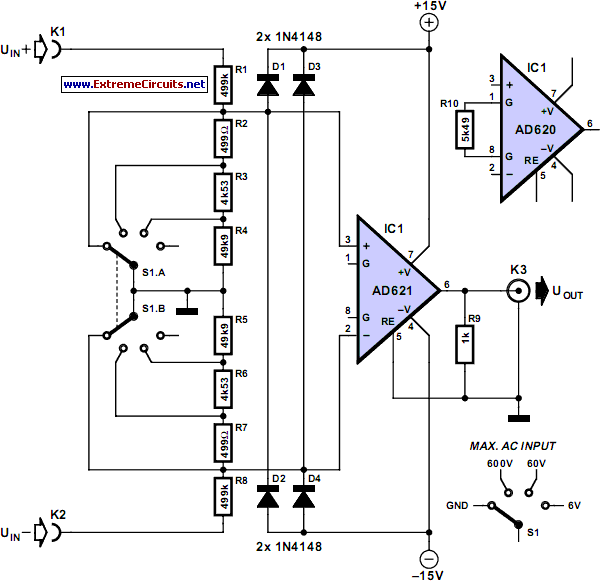Home » Circuits
Meter Adaptor With Symmetrical Input
In contrast to an ordinary voltmeter, the input of an oscilloscope generally has one side (GND) connected to ground via the mains lead. In certain situations this can be very problematic. When the measuring probe is connected to a circuit that is also connected to ground, there is a chance that a short is introduced in the circuit. That the circuit, and hence the measurement, is affected by this is the least of your problems. If you were taking measurements from high current or high voltage (valve equipment) circuits, the out-come could be extremely dangerous! Fortunately it is not too difficult to get round this problem.All you have to do is make the input to the oscilloscope float with respect to ground. The instrumentation amplifier shown here does that, and functions as an attenuator as well. The AD621 from Analog Devices amplifies the input by a factor of 10, and a switch at the input gives a choice of 3 ranges. A ‘GND’ position has also been included, to calibrate the zero setting of the oscilloscope. The maximum input voltage at any setting may never exceed 600 VAC. Make sure that R1 and R8 have a working voltage of at least 600 V. You could use two equal resistors connected in series for these, since 300 V types are more easily obtainable.
Circuit diagram:
You should also make sure that all resistors have a tolerance of 1% or better. Other specifications for the AD621 are: with an amplification of 10 times the CMRR is 110 dB and the bandwidth is 800 kHz. If you can’t find the AD621 locally, the AD620 is a good alternative. However, the bandwidth is then limited to about 120 kHz. The circuit can be housed inside a metal case with a mains supply, but also works perfectly well when powered from two 9V batteries. The current consumption is only a few milliamps. You could also increase R9 to 10 k to reduce the power consumption a bit more.
Author: Aart Rombout - Copyright: Elektor July-August 2004

